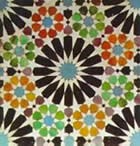"The art of Islam is essentially a contemplative art, which aims to express above all, an encounter with the Divine Presence. The origin of Islamic art has often tried to be explained through tracing it back to some precedent in Byzantine, Sassanid, Coptic or other art, yet what is lost sight of, is the intrinsic and original unity of Islamic art and thus the 'seal' that Islam conferred on all borrowed elements."The emphasis is on the geometrical, understandably enough, given the restrictions on naturalistic imagery. The emphasis in Christianity, at least after the defeat of the Iconoclasts in the 8th century, was almost the exact opposite. The Incarnation of Christ, and the images of Jesus clasped in the arms of his Mother (an icon that even Muhammad pbuh refrained from destroying when when he purged the Ka'bah), overcame all resistance to the idea of naturalism, even though such images were both natural and symbolic to the highest degree. The two key images that determined the foundations of Christian art were that of Christ on the Cross, and that of the Madonna and Child, the child's face pressed lovingly against that of his Mother.
From these (or from the tension between these) exploded the treasures of Christian civilization: the shapes of churches, the glories of stained glass, and gradually the splendors of naturalism, as the golden backgrounds gave way to atmospheric landscapes, and the formalized poses of the icons were transmuted into detailed portraits of people known to the painter and his patrons. The accurate naturalism of the earlier Fayum portraits was retrieved and rescued for the tradition of Christian painting, even if it led through the Renaissance to the Baroque and (in its decline) to a period of degeneracy and sentimentality from which we are still trying to escape.



This sounds like such an interesting discussion--wished I lived closer so I could participate! Stratford, I used a chapter from your book (Beauty for Truth's Sake) as one of the assigned readings last year when I was teaching educational psychology at a secular university (in the week on religious education). Interestingly it was the Muslim students in my class who really resonated with it. Not surprising that they resonated with a theistic account of education, I suppose, but still somewhat surprising given the heavy emphasis on Logos. I wished I had had the freedom to really go deeper in discussion with them but I was really thankful for such a great reading to get them thinking. I really appreciate the book's take on education! It articulated so well what I wanted my students to take away from the course.
ReplyDeleteWishing you well,
Elissa